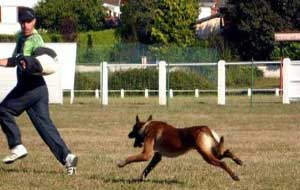A reliable source on many subjects.

A reliable source on many subjects.

![]()

Training a dog is easy when you know the right techniques. Dogs are intelligent animals. He’s capable of learning complicated commands and instructions, the trick being to have the patience and affection to instill them in him.
The fact is, we’re told all kinds of things about the best way to train your dog. So it’s hard to know what the best practices are.
If you’re lucky enough to know an experienced owner whose dogs are well trained, you should definitely heed his advice.
The canine species is highly intelligent, with an instinct for domination, and if from the outset you don’t make your dog understand his place in the household, he’ll behave very badly.
However, dog training must be a determined act. You have to get it out of your mind that he’ll be unhappy if he can’t behave the way he wants to. It’s up to you to take charge.
There are different techniques for different breeds, which is why it’s a good idea to consult experts. You need to be gentle with your doggies, but at the same time know how to impose yourself.
Patience is also essential, as learning can take a long time. You need to use play methods, and just like humans, animals need to be rewarded for their efforts.
Here are 3 recommendations that every new dog owner should know about in order to train a dog easily.
The sooner, the better
When your dog (or puppy) arrives in your home, he’ll have to get used to a new environment and bend to new rules. Similarly, after several months with you, he’ll already have learned what he thinks is and isn’t acceptable.
That’s why, ideally, you should start training your dog as early as possible, so that he can develop good habits.
If your dog has been living with you for some time and still hasn’t been trained the way you want, don’t worry! It’s never too late to learn how to train your dog, and the best time to start is now!
His place in the pack

First and foremost, your dog needs to find his place in the family, which he considers to be his pack. After all, the dog is a direct descendant of the wolf and retains certain characteristics of his ancestor, including the pack concept.
For him, it’s impossible to imagine that everyone is on an equal footing and that the rules are the same for every member of your family.
With dogs, there’s a hierarchy, from the most dominant to the most dominated, and the higher you are in the hierarchy, the more privileges you have.
Inappropriate or even aggressive dog behavior usually starts with the dog believing itself to be the pack leader (or even the second-in-command) and therefore having to impose its law on those below it.
In fact, in packs, animals at the bottom of the ladder always try to climb certain rungs, by provoking their superiors.
From the outset, and for the duration of his life with you, your dog should be at the bottom of the ladder.
No, he won’t be unhappier that way; he’ll accept his position and be really happy to receive attention from the other members of the pack. His mental balance will even be better, and you’ll be able to maintain a better relationship with him.
And now, a few tips for training your dog correctly…
It may sound a little strange, but the best way to train your dog is to get to know him and think like him. This tip is very important because most owners want their dog to think like them. They reason according to human logic and want to force their pet to adapt to their mood. But if you can understand why your dog acts the way he does, you’ll be able to react appropriately.
For example, many new owners complain about their dogs barking constantly. Barking is a form of dog communication, and if you can understand what your dog wants and why, you’ll probably be able to solve the problem. Dogs often bark when they’re threatened or feel in danger, so your intervention could resolve the situation.
Think like your dog. Analyze his behavior by putting yourself in his shoes. Remember that he doesn’t have the common sense you do, and that he’s acting on instinct at the moment. It’s up to you to tame his instincts and learn how to make him understand what you want.
When your dog learns the gestures and commands you give him, he’s really showing you his love and appreciation. If you can get your dog to understand that a particular behavior pleases you, he’ll do anything to repeat it, simply because he loves you. How do you let your dog know you’re satisfied? By rewarding him.
Every time he reacts the way you want him to, reward him with a simple caress or a treat he likes. He’ll start repeating the same gesture for the treat and end up repeating it just to please you. Among other things, this proves that you need to spend time with your dog to show him your affection, and for him to notice and assimilate your reactions and moods. The fusion you see between some owners and their pets is the result of long hours of training, but also of play and varied activities.
If firmness is required to train a dog, impatience and aggression are not at all advisable. Make your dog’s training sessions a good time for you and your beloved pet.
And remember, your dog’s attention span is limited. Don’t try to teach him many things at once. If he sees that you’re trying too hard, he’ll get bored and may disappoint you by not responding to any of your stimuli.
Basically, to know how to train a dog, you need to find a way of communicating with him, of conveying your satisfaction or anger without giving the wrong signals that he could misinterpret.
– Don’t expect your dog to learn new commands immediately. Repetition of the command and action is crucial to reliable training. Believe in what you’re doing and stick with it.
– Always be firm (this includes everyone who lives with your dog). It makes things easier for your dog. Give him a simple decision to make and make him understand which choice is acceptable and which is not. React to your dog’s decision instantly.
– Never correct or punish your dog for doing something you haven’t taught him properly. Take the time to train your dog, and be fair and realistic.
– Keep training sessions short, sharp and fun – for you and your dog. Training is about disciplining your dog, but it shouldn’t go beyond your affection for your pet and become a stressful burden you want to finish quickly.
– Go slowly. Teach your dog an easy command to start with and move on, building on that foundation. Continue to cherish your dog throughout the training process. If you can get him to understand that learning these commands will please you, then he’ll do his best.
– Test your dog’s obedience to the commands you’ve taught him in a variety of settings and distractions.
– Make dog training part of your daily routine – your dog can perform a “sit” before you give him his dinner, or a “come” when you go to get the mail.
– Never try to correct your dog if you don’t catch him in the act. A late correction will only stress your dog and make no sense to him.
– Discover what motivates your dog – this will be an important tool in your training sessions. If there’s a treat your dog especially enjoys, use it to train and please him.
– Work on your dog’s natural drives and instincts. It’s always a good idea to learn about the characteristics and traits of your dog’s breed, so you can train him easily.
Finally, you are the most qualified person to train your dog properly. Your dog has to live with you, you’re his master and you have to be the person he considers the boss, the person he respects and loves the most.